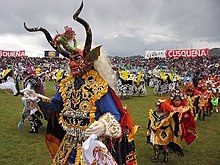This is an old revision of this page, as edited by MarshalN20 (talk | contribs) at 02:13, 19 August 2009 (Grammar edit and made the pictures standard size (thumb size).). The present address (URL) is a permanent link to this revision, which may differ significantly from the current revision.
Revision as of 02:13, 19 August 2009 by MarshalN20 (talk | contribs) (Grammar edit and made the pictures standard size (thumb size).)(diff) ← Previous revision | Latest revision (diff) | Newer revision → (diff)

The Diablada is a South American dance that was created in the Andean Altiplano but holds auto sacramental origins in Spain. The dance is practised throughout the Andean region, and is an important part of the cultural festivities of the nations of Peru, Bolivia, and Chile. The dance stands prominent during the Fiesta de la Candelaria in Peru, the Carnaval de Oruro in Bolivia, and the Fiesta de la Tirana in Chile. However, the dance is also practiced in Venezuela, Ecuador and Panama.
The oldest Diablada is recorded to have taken place on Juli, Puno, in the area of present-day Peru. In the XVI century, Jesuit missionaries spread the autos sacramentales, a dramatic representation of the mystery of the Eucharist, in the Viceroyalty of Peru, beginning in the city of Juli. During the evangelism of the native Lupacas people of Juli, the Jesuits made a representation of the seven deadly sins that concluded with the victory of the angel, which represented good. Due to the mixture of cultures that took place in this city, it was known as the "little Rome of America" and the "Aymara's Rome".
The Diablada caused a reform in the thinking of the indigenous Altiplano cultures as missionaries from Spain, instilled the paradigm of good and evil, which is how the costumes of angels and demons became associated with the dance.
Miss universe dispute
In August 1 of 2009 Bolivian officials stated that it could present a legal appeal to the organizers of Miss Universe due to the planned use of a typical Diablada wear by the Peruvian candidate Karen Schwarz. Pablo Groux, Bolivian minister of Culture, said that any use of the wear by Scharwz in the content would be an unlawful appropriation of Bolivian heritage and have menaced to bring the case to the International Court of Justice. El Comercio, a Peruvian newspaper, have mentioned that this is not the first time the diablada wear is shown in the contest and that it was María Josefa Isensee, a Chilean, that first used it in the Miss Universe contest. Peruvian foreign minister José Antonio García Belaúnde said that since the Diablada dress is of indigenous Aymara origin it can not be considered exclusive of any of the countries where Aymaras lives.
See Also
References
- Perú y Bolivia incluyen a Chile en disputa por traje de Diablada El Mercurio
- Bolivia rechaza que representante peruana en Miss Universo use traje de la "Diablada" El Mercurio
This dance-related article is a stub. You can help Misplaced Pages by expanding it. |